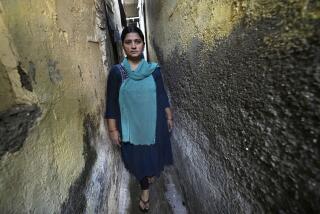Indiaâs population hurtling toward the top
Reporting from New Delhi â
Aastha Arora is one in a billion. At least thatâs what they called her when she was born on May 11, 2000.
Designated with great fanfare as the symbolic 1 billionth Indian, Aastha â her name means âfaithâ in Hindi â is now called something different. âThey call me âthe special childâ at school,â the perky sixth-grader said, in the familyâs two-room apartment. âTeachers, friends know about the big ruckus when I was born.â
In the last 11 years, India has added 240 million people and, according to U.N. estimates, is on target to surpass China as the worldâs most populous nation in 2020.
Aasthaâs mother, Anjana, recalls being wheeled out of the delivery room after a tough birth, more difficult than that of Aasthaâs brother, only to face about 100 television cameras.
âThis is like a dream,â she told a reporter at the time, even as she feared for her babyâs health with all the commotion.
While China has slowed its birthrate dramatically under a controversial one-child campaign, India has relied on voluntary measures. Indiaâs fertility rate has dropped by more than half since 1950, but progress has been uneven because population planning programs are run by individual states, not the central government.
India enacted more coercive methods from 1975 to 1977 during the so-called emergency period, which left a bitter taste. Ratna Jaitley, 75, then a teacher at a government school in New Delhi, said she was ordered to find men to sterilize or risk losing her job, a demand justified at the time for reasons of national development.
With great anguish, she offered up two families that washed and ironed clothes, one with six children, the other with eight, figuring theyâd already had quite a few offspring.
âA lot of people in my position took undue advantage of the poor and the uneducated,â she said. âMany childless and newly married were sterilized.â
Even as some economists talk about Indiaâs âpopulation dividendâ in coming years â the idea being that young populations tend to be more economically vibrant and productive â thatâs premised in part on educating the citizenry and providing suitable opportunities.
But some are skeptical, given Indiaâs spotty record in preparing young people for the job market.
âThere are quite a few challenges for India ahead,â said K. Srinivasan, professor emeritus with Mumbaiâs International Institute for Population Sciences. âThe biggest is going to be providing employment to the millions and millions coming up that arenât skilled or qualified or [donât] have access to education.â
Large families often have the fewest resources. âIndiaâs remaining population predicament is the same as in the rest of the developing world: Population growth remains stubbornly high in the poorest countries and, within countries, in the poorest areas, helping to keep them poor,â said O.P. Sharma, New Delhi-based consultant with Washingtonâs Population Reference Bureau, a civic group.
Even as headlines tout Indiaâs space program, glitzy call centers, fast-growing economy and rising middle class, the nation is struggling to feed, clothe and house many of its people amid the population growth, corruption, inefficiency and weak government.
A report released recently found that the poor in India were better fed 30 years ago, and that India is worse off than its neighbors and many sub-Saharan African countries. The picture is similar in health, hygiene, education and womenâs status.
Educating and otherwise raising womenâs stature is a key to curbing runaway population growth, development workers say, yet India came in 113th of 135 countries on womenâs status, according to a ranking by the Geneva-based World Economic Forum.
If anything, rising wealth has reduced womenâs stature, sociologists say, because the cost of dowries has skyrocketed, leading to more female infanticide and abortions after the sex of a fetus is determined.
Indians were shocked recently to find that hundreds of girls in eastern Maharashtra state had been named Nakushi, a word that means âunwantedâ in the Marathi language. Maharashtra has some of the lowest girl-to-boy ratios in the country. In October, the state held a naming ceremony allowing the âunwantedâ women to choose new names.
Jayashree, known as Nakushi until lately, said she got used to being labeled âunwantedâ by her family and neighbors. âI accepted it,â she said. âIt was just a normal thing.â
When Aastha was born at 5:05 a.m. in New Delhiâs Safdarjung Hospital â officials had expected a birth shortly after midnight, but other candidates were stillborn or ended up being born later â the hospital was inundated not only with reporters but doctors, senior bureaucrats and politicians eager to share the limelight. In front of the cameras, the dignitaries made all sorts of promises: that the family would enjoy free rail tickets for life, free medicine and free education and that the babyâs father would receive a government job.
âThey never fulfilled anything,â her mother said, in their combined living room and bedroom, barely large enough for a bed and chairs. âThey raised our hopes to the sky, then dashed them.â
The one gift that was delivered was a $4,000 fund to be used for education once Aastha turns 18, and even that took months to chase down. A letter confirming the gift said that âthe best way to reduce population is to educate the girl child.â
Aastha says she likes to draw, enjoys science and is thinking of becoming a doctor, or maybe a flight attendant. âAirplanes are so exciting,â she said. âIâve never been in one, but I watch them in the sky. Itâs so exciting when you see them.â
Tanvi Sharma in The Timesâ New Delhi bureau contributed to this report.
More to Read
Sign up for Essential California
The most important California stories and recommendations in your inbox every morning.
You may occasionally receive promotional content from the Los Angeles Times.










